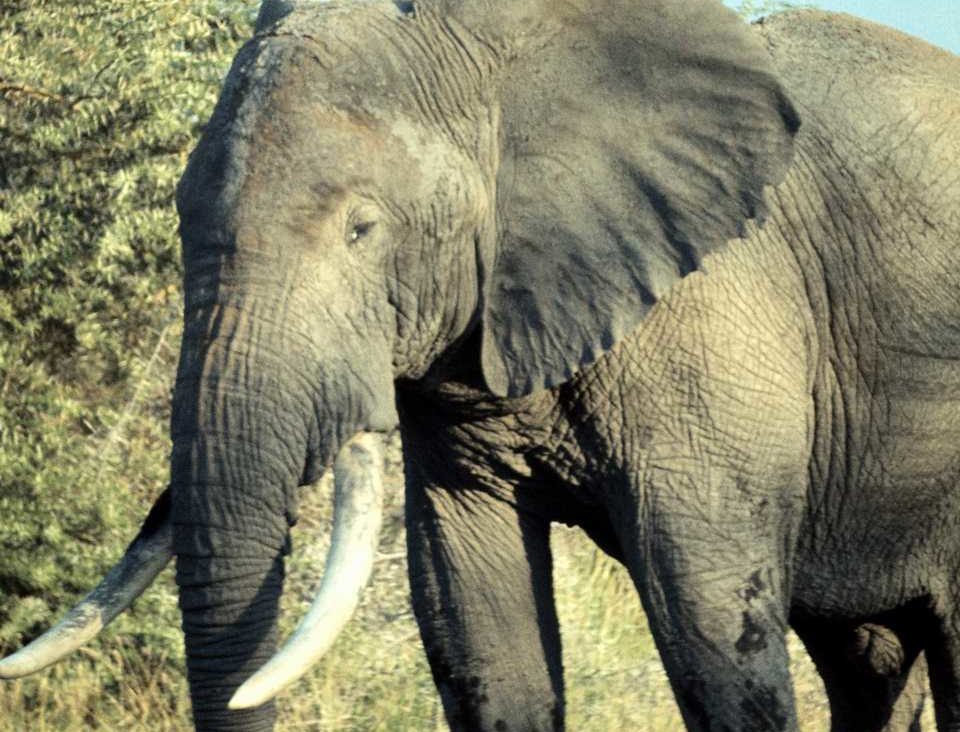The African elephant is the largest living terrestrial mammal, even larger than most dinosaurs. Its mammoth size means their primary enemy is humans, not the major carnivores, such as lions, that inhabit its homeland. The largest recorded African elephant reached 12 feet (four meters) at the shoulder and weighed over ten tons. Called “nature’s masterpiece” and “skilled engineers” elephants are one of “the most intelligent of domesticated animals.” (Redmond, 1993, p. 6).
Three elephant species are currently recognized: the African bush elephant (Loxodonta africana), the African forest elephant (L. cyclotis), and the Asian elephant (Elephas maximus). African elephants thrive in eastern, southern and western Africa. Also, many extinct elephants once roamed the earth, including the mammoths and mastodons. (Redmond, 1993, p. 10). They are all herbivorous and found in many different habitats including savannahs, forests, deserts, and marshes that contain abundant grasses and other plant foods.
The main differences between the African and Asian varieties include the fact that African elephants are larger, fiercer, and have much larger ears and concave backs while Asian elephants have much smaller ears and convex or level backs. Asiatic elephants were domesticated centuries ago and are the most common species used in circuses (Moody, 1970, p. 217).
The Trunk
An example of the many wonders of elephants is the trunk, formally called a proboscis, thus they are classified in the order Proboscidea. Close to 150,000 muscles are used in its trunk, about 230 times the number of muscles in the average human. This complex muscle system allows the trunk to move in almost any direction. The trunk functions as a nose to breathe, but also to drink, and as a pump to pull water into its body as well as to spray water out to clean itself and clear insects from its body (Ault, 2016, p. 106). It also functions as a snorkel to allow an elephant to breathe when under as much as 6 feet of water. Its most well-known function is as a hand to put food in its mouth, as well as to lift and carry a wide variety of weights. It is sensitive enough to pick up a peanut, even a pin, or uncork a bottle, yet strong enough to rip a branch from a tree or lift up to 600 pounds (270 kg). The trunk’s self-repairing well-placed muscle system explains how it can achieve these feats (Moody, 2017. p. 217).
The trunk is also used for vocalization, greeting and other social behaviors. Elephants use infrasound, low-frequency calls that allow them to communicate over long distances. Two-thirds of their calls are emitted at a frequency below the range of human hearing, which requires electronic translation for humans to hear what they are saying. Unfortunately, we have tried, but humans have not been very successful in understanding the meaning of most of their vocalizations. Besides sound, they also communicate by touch, sight, smell, and seismic communication over long distances.
The Tusks
The specially designed tusks, which serve as weapons and tools for moving objects and digging, are a major distinctive trait of elephants. The tusks are actually extended upper incisor teeth, and are located on both male and female African elephants, whereas only a few Asian males have tusks. About half of Asian females have short tusks known as tushes which lack most of the pulp inside the tusk compared to African Elephants. Elephants normally prefer to use one tusk over the other, known as the master tusk, similar to being left or right handed.
The main enemy of elephants is humans who kill them mostly to obtain their tusks for their valuable ivory. Because poachers have consistently preferred animals with the very best ivory, over decades an increasing number of African elephants are now born without tusks, altering the gene pool so that eventually, in the future, most may lack tusks.
The Ears
Another distinctive trait of elephants is its large floppy ears. The elephants’ ear flapping helps to control their body temperature, a problem in the hot climates in which many live. The blood flowing through the ears is close to the outside of the body, allowing heat to dissipate as they are flapped back and forth in the air. Like a dog’s tail, their ears are also used to communicate emotions, including both aggression and joy, to other elephants.
Its Evolution
Considering its size and the thickness of it bones, much fossil evidence should exist to document elephant evolution from some smaller ancestor. Furthermore, the fossil evidence is so great that elephants were believed to be successful to the extent that they “dominated most of the large herbivore faunas of the world” in the Pleistocene community (Spinage, 1994, pp. 16-17). The most authoritative reference on elephants is Spinage, who has only a little over one page on elephant evolution but seven pages on the extinction of the many elephant relatives (Spinage, 1994, pp. 17-23).
For these reasons, abundant evidence of their evolution should exist. In spite of extensive searching, no plausible fossil or other evidence exists of their evolution from a smaller ancestor. This is especially problematic because “elephants are unlike any other group of animals alive today,” thus its close relatives, if they existed, should stand out from other animals (Redmond, 1993, p. 12).
The claims of elephant evolution are very confusing because, like cats, many extinct animals are assumed to be related to them. So far, over 185 extinct members and three major families in the order Proboscidea have been documented (Kingdon, 2013, p. 173). The leading paleontologist, Henry F. Osborn (1921), identified some 352-Proboscidean species and subspecies, of which only half are still recognized as valid today. The now extinct members of the order Proboscidea include mammoths, mastodons, and two lesser known animals, deinotheres and gomphotheres.
The classical evolutionary view of “proboscidean evolution seems to have started with a rather small animal living in the Eocene” called Moeritherium, a pig-like animal that was about 2.3 feet in height and weighed close to 518 pounds (235 kg), which is about the size of a modern tapir (Moody, 2013, pp. 220-221).
Arguments against Moeritherium being an elephant precursor include its lack of an elephant-like trunk and its resemblance closer to a sea cow more than to an elephant. Moeritherium also had small incisor teeth shaped more like those of a hippo than an elephant (Redmond, 1993. pp. 8-9). Nonetheless, no better example of an elephant precursor has yet been located. Even the elephant phylogeny tree shows only a series of separate animals placed in a bush arrangement, indicating only vague relationships closer to a family than an evolutionary tree phylogeny (Moody, 1970, p. 221).
The evolutionary assumption is that the trunk and tusks slowly evolved from short, small appendages to the large sizes that these structures exist in today. Consequently, these two traits are critical in selecting potential evolutionary links that end in modern elephants. The problem is, so many other traits of the potential elephant precursors do not fit into the evolutionary pattern, even though we have almost 200 possible extinct examples from which to select. The ones chosen are the best fit of those available, but are still, at best, very poor fits.
The latest extinct relative of an elephant is thought to be a Stegmastodon, which “would look pretty much like modern elephants if they were alive today,” and their “main difference from elephants is in their molar teeth, reflecting a diet more based on browsing than that of modern elephants.”[1] Thus, this animal appears to be only a minor variation of modern elephants in spite of their very different name. Assuming the existing fossils are representative of the Stegmastodon animal, as they date from Pliocene rocks, they indicate that the first elephant was a modern elephant. The problem of determining elephant evolution is also very difficult because:
Understanding how extinct species are related to each other or to their living relatives is often a difficult task. Many extinct species have been identified only from incomplete fragments of some of their bones. However, even if complete skeletons have been found, determining the relationships between species can be tricky because researchers often have to rely solely on the shapes of the bones (Myer, 2017, p. 1).
It was hoped by Darwinists that genetic analysis would help clarify elephant phylogeny, but so far it has created even more major questions about existing evolutionary trees. The authors of one study that attempted to achieve this task concluded: “Our results demonstrate that the current picture of elephant evolution is in need of substantial revision” (Myer, 2017, p. 1). In short, after looking for almost two centuries, no plausible evidence for elephant evolution exists. The first elephant was an elephant. We cannot even imagine an evolutionary process that would be required to produce all 150,000 muscles in the trunk and the complex nerves and brain to control them!
References
Ault, Charles. 2016. Do Elephants Have Knees? Ithaca, NY: Cornell University Press.
Chadwick, Douglas. 1991. Elephants — Out of Time, Out of Space. National Geographic. 179(5):2-49. May.
Redmond, Ian. 1993. The Elephant. New York: Knopf
Kingdon, Jonathan. 2013. Mammals of Africa. London: Bloomsbury.
Meyer, Matthias. et al, 2017. Palaeogenomes of Eurasian straight-tusked elephants challenge the current view of elephant evolution, eLife. https://elifesciences.org/articles/25413.
Moody, Paul Amos. 1970. Introduction to Evolution. 3rd edition. New York: Harper and Row.
Osborn, Henry Fairfield. 1921. The Evolution, Phylogeny, and Classification of the Proboscidea. American Museum Novitates. January 31.
Spinage, Clive. 1974. Elephants. London: T& AD. Poyser.
[1]https://newscenter.nmsu.edu/Articles/view/12599/nmsu-experts-dig-up-las-cruces-boy-s-million-year-old-fossil-find; http://www.foxnews.com/science/2017/07/18/10-year-old-trips-into-million-year-old-dinosaur-fossil-discovery-in-new-mexico.html. https://phys.org/news/2017-06-genetic-elephant-family-tree.html.
Jerry Bergman
April 2018
Subscribe to Dialogue







